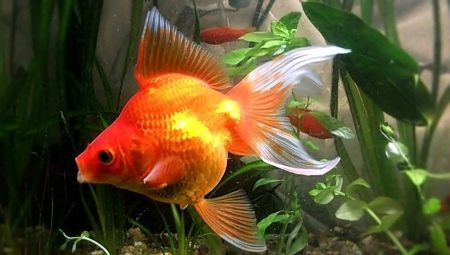Many beginners and experienced aquarists are attracted to the original goldfish with stunning tails and chic fins. They are interested in features, varieties of veil-tails, tips on care, reproduction and feeding of unusual aquarium inhabitants.
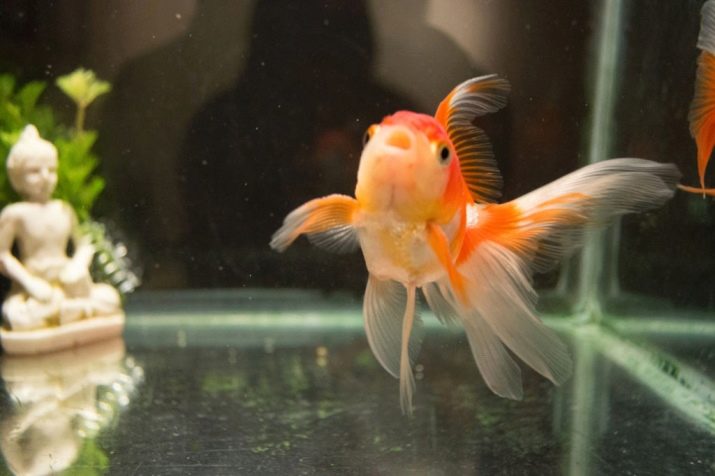
Features
In natural nature, the veiltail does not occur. Selection of decorative fish was made in China from the most common and very common crucian carp. But Japan is considered to be considered the homeland, since it was from there that it got to Europe.
Aquarium fish veiltail from other representatives of this species is distinguished by a short ovoid body. A characteristic feature is a forked, fluffy and very long tail. It looks like a light, almost weightless fabric. Compared to other representatives of this species, the transparent fins are elongated.
The head is decorated with large eyes. The length of the fish can reach 20 cm. A short body, a smooth transition of the head into the body does not allow it to keep up with the other inhabitants of the aquarium on the way to the feed. Life expectancy in good conditions is 10-15 years or more.
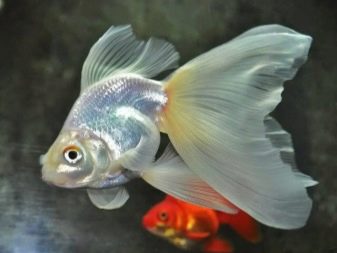
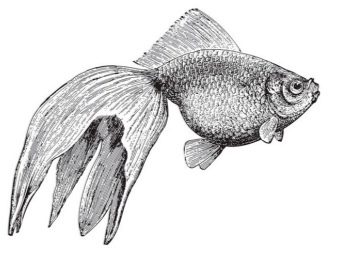
Coloring is the most diverse: from pale pink to fiery red. There are individuals with black, blue, purple, green, yellow, bronze tint. Golden and red colors are especially common. There are one-color, two-color (the body has one tone, fins and tail - a different shade), multi-color (a variety of color spectrum of all parts) veils.
During the first year of life, it is very difficult to distinguish a male from a female. In adulthood, the male is determined by its small size. He is always interested in new fish, immediately swims to them. The female does not show any interest in the relatives who have just appeared in the aquarium.
During spawning, males form white tubercles on gill covers and along pectoral fins. Notches resembling a saw appear on paired front fins. The female has a brighter color, a round abdomen and a large size. Against the background of the round and short abdominal fins of a female, the males have a pointed look.
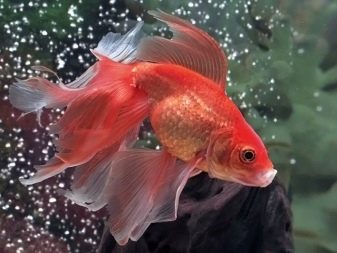
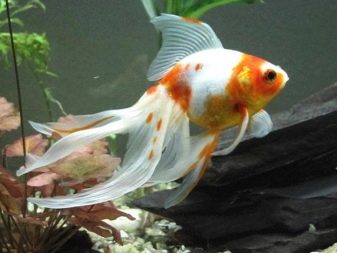
Varieties
There are scaly and scaly species of these cold-blooded. Individuals may vary in color. There are albino fish. Very rarely come across blue-eyed veil-tails. A large number of inhabitants of the aquarium with an interesting combination of colors. Most often, each fish consists of two or three colors. The following varieties are found.
- Chintz veiltail characterized by orange, white and dark spots. He looks awkward, with difficulty swimming due to the large fins.
- A rare and valuable species are the inhabitants of the aquarium black and red with various forms of fins.
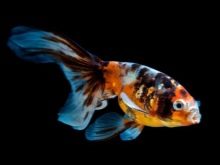
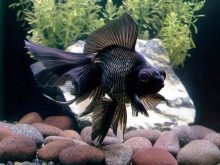
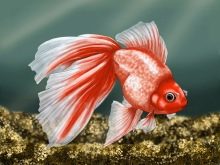
According to the shape of the tail, such species are distinguished.
- The classic veil tail includes two identical tail blades that resemble a skirt.
- The fan tail has a right angle between the upper and lower parts of the fin. Its tail is like a fan, the length of which is equal to half the body.
- Tape variety implies 3 or 4 blades. The tail of such a fish is like a beautiful lush veil.
The more blades, the more valuable the veiltail.

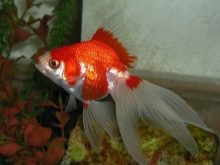
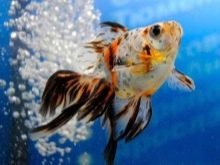
Care Rules
Goldfish are unpretentious and undemanding to temperature, hardness and acidity of water. They feel great in a pond, any artificial pond and aquarium. The fish produces a large amount of waste, so it requires a tank with a capacity of at least 100 liters of water. For each subsequent individual, it is necessary to add another 50 liters of liquid.
Water needs to be constantly changed: one third of the volume should be updated weekly. Despite this, an external filter must be used. Voile tails prefer water of cool temperature - in a room with a plus temperature, special heating of the liquid is not required. Direct UV radiation on a fish tank is undesirable. Too warm water does not suit them.
Voile tails calmly tolerate temperatures below 10 degrees. For this reason, their maintenance along with tropical individuals is not recommended. In addition, some species of aggressive fish can bite gorgeous tails and fins with veil tails. Fast and nimble guppies, thorns, Sumatran barbs do not get along in the same container with goldfish. Neighborhood with perky inhabitants is undesirable: a sickle can quickly strip off slow and peace-loving fish with gorgeous fins and an amazing tail.
Small neighbors are also not recommended to settle in the aquarium - the gold inhabitants of the aquarium can easily swallow them. Related species should be placed in one container. The best neighbors for veil-tails are telescopes, shubunkins and pearls.

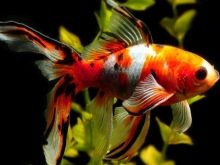
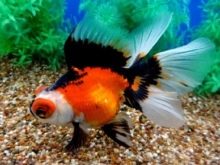
The use of sand or gravel is recommended. Representatives of this type of fish love to dig and dig in it. But gravel must be taken on a large scale to avoid swallowing, which often leads to the death of fish.
It is desirable to place large-leaved plants in the tank. Vegetation with hard leaves and a strong root system is well suited, since veil tails have a habit of nibbling them. Elodea, egg capsule, wallisneria and sagittaria are recommended.
It is undesirable to populate these fish species in a round container. This form contributes to visual impairment and growth retardation. Ideal is the content of veil-tails in a rectangular aquarium with shelters in the form of grottoes and non-sharp snags.
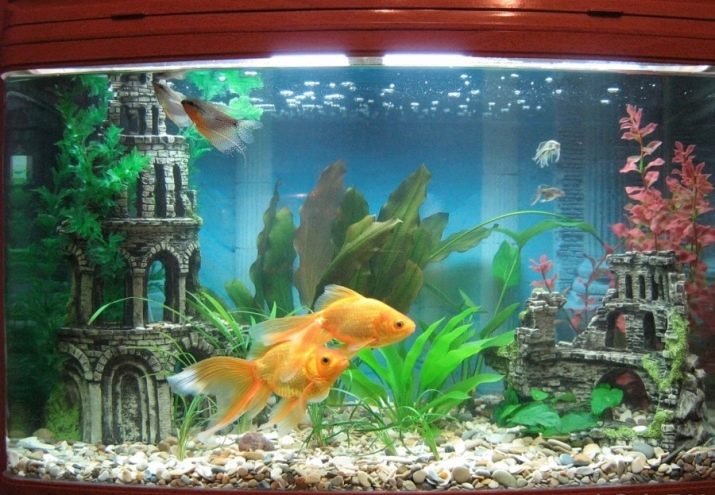
Feeding
Veil-tailed fish do not have a stomach, so the feed goes directly to the intestines. Food consumption occurs continuously until it disappears completely. Food is not digested, therefore, overeating fish often die. It is very important to correctly calculate the amount of food. Inhabitants of the aquarium need only two meals a day. Serving should be designed for 10 minutes of eating. It is advisable to remove the excess from the tank.
It is necessary to provide pets balanced nutrition. For the golden inhabitants of the aquariums, special feeds in the form of granules are intended. They are convenient in that they do not decay, but settle on the bottom. Granules are easy to dose. Voile tails are suitable for live, vegetable, frozen, artificial feed. But they must be given with caution, as many of them are too nutritious for the voracious goldfish.
The diet needs to be diversified. Dry and vegetable feed must be present. From time to time, you can feed veil tails with duckweed, scalded nettle and lettuce. Plant foods should be alternated with protein foods. For one meal, different types of food are not recommended.
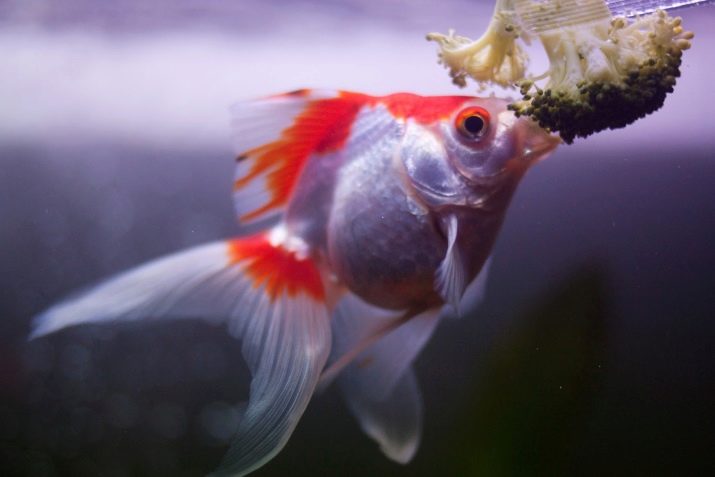
To avoid obesity, once a week, fish should not be fed at all. If a fish, while grabbing food from the surface of the water, has taken in a lot of air, it can swell a lot and fall to one side. In this case, it does not need to be fed for a day.
Breeding
Spawning of veils is carried out in March-April. One female requires 2-3 males of two years of age. Before spawning, females and males should be kept separate for two weeks. They should eat plentifully. Then, heterosexual individuals are released into the aquarium with sandy soil and a special spawning grate. In the corner of the tank you need to put a bunch of small-leaved plants.
Spawning is stimulated by gradually increasing the temperature of water to 26 degrees. Males immediately begin to show activity and chase females.
Spawning begins in the early morning and lasts for 5 hours. Appears up to 10 thousand eggsthat must be left in the aquarium, and manufacturers should be removed from them. For two or four days the eggs are incubated. After 5 days, fry appear.
The live dust is sold at the pet store, designed to feed newly hatched fry. They eat their own brine shrimp, ciliates, and rotifers. After 2 weeks, young growth passes to small cyclops. Fry can be fed from 2 to 4 times a day. When young growth reaches 3 cm, it is placed in an aquarium for adults.

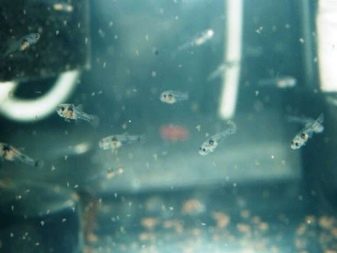
Tips for beginners
- The maintenance of veil-tails in a spacious aquarium is recommended. There they feel comfortable, live long and do not get sick.
- To maintain a stable temperature in the aquarium, it is necessary to use a thermometer placed in water. The ideal temperature is 20-22 degrees.
- Sometimes the concentration of nitrogen compounds in the tank exceeds the norm. As a result, representatives of veiled-tail species receive burns, which are observed on the body of cold-blooded. In this case, the accumulated poisons of ammonia, nitrite and nitrate must be immediately removed from the tank by completely replacing the water.
- To prevent fish disease, new individuals should live separately from them. After a month of quarantine, they are placed in a common aquarium.
- Acquired small individuals, when growing up, sometimes tend to completely change color. For example, a golden veiltail can completely turn white.
- Goldfish love to lie on the ground. Do not be scared. An active healthy individual without any signs of illness simply rests.
- Long fins are easily injured, so in the aquarium there should be no pointed objects and stones, needle-like knots. An individual may be injured and lose part of its luxurious tail or beautiful fin.
- Abdominal distention and protruding scales may indicate dropsy.It is necessary to conduct antibiotic treatment.
- Fin rot, which affects the body and fins of the cold-blooded, should be treated with drugs.
- During the poor health of the veiltail, a little salt is added to the water - 5-7 g / l.

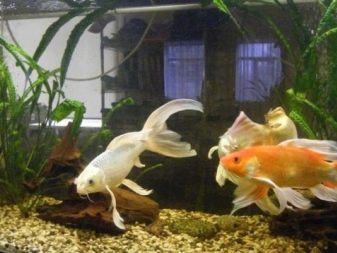
In order to increase the immunity of the inhabitants of the aquarium, you can slightly add salt to the water.
About the features of caring for goldfish, see below.
